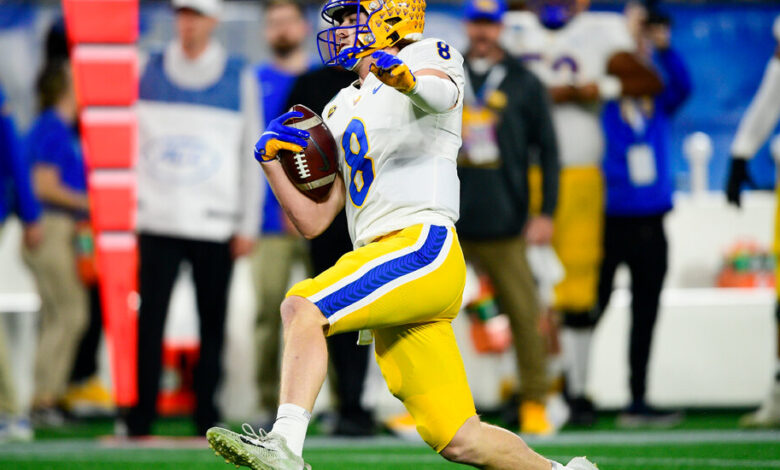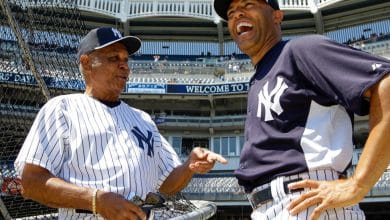College Football Is Back. Don’t Even Try That Fake Slide.

For all that does not seem to change in college football — Alabama around the top of the polls, hype about Texas, Kirk Ferentz as Iowa’s coach — the sport’s rule book gets some rewrites and tweaks before every season.
Here are some of the revisions taking effect this year.
Call this the Kenny Pickett Rule.
Kenny Pickett, Pittsburgh’s quarterback last season, did not win the Heisman Trophy, finishing third in the vote. But maybe Pickett should have won an Oscar for his touchdown-triggering fake slide during the Atlantic Coast Conference championship game. Now, that play has given him a place in college football history: rule change instigator.
The rewritten rule is basic: “Any time a ball carrier simulates or fakes a feet-first slide, the ball should be declared dead by the on-field officials at that point.”
The judgment of whether a ball carrier slid is not subject to review, but instant replay officials can intervene on ball placement.
Steve Shaw, the N.C.A.A.’s national coordinator of officials and its secretary-rules editor for football, said football leaders regarded the matter as a safety issue.
“If we didn’t take action, the fear would be then in the next game, the quarterback slides feet-first, but the defender says: ‘I’m not going to be fooled again. I’m going to go ahead and drill the guy,’ and that’s not what we want,” Shaw said. “The hope of this rule — and I believe it will be so — is that it just takes that technique out. In other words, now the players know they can’t fake slides, so they’ll either slide or not.”
But Shaw, a Southeastern Conference referee for 15 seasons before he became the national coordinator, said Pickett’s play last December showed how the evolution of the game sparks swift changes.
“Most rules are long-in-coming and planned and that sort of thing,” he said. “But occasionally, we have a one-play situation that creates a rule change, and that’s what we have here. That’s the only one I’ve seen, that’s the only one we have on video, and hopefully with this rule change, that’s the last one we see.”
Will the third time be the charm on feigned injuries?
We are still talking about feigned injuries because the N.C.A.A. still hasn’t figured out a meaningful way to stamp them out of college football. Indeed, this season is the third consecutive one with a new strategy that executives acknowledge might not actually work.
Under the new policy, colleges or leagues may ask the national coordinator of officials to review “questionable game action” and report the findings to conference offices, which can take unspecified “further action.” (Last year’s approach was to send the coordinator’s findings to the offending player’s athletic director.)
“That’s raising the stakes on it quite a bit,” Shaw said. He added that although there had not been “an enormous amount” of officially reported suspicions, officials had received informal inquires about potentially feigned injuries almost every week of last season.
Greg Burks, who oversees football officiating for the Big 12 Conference, said, “Coaches hate calling in on other coaches, right? I mean, that’s the last thing they want to do.
“They would like somebody else to deal with it, and so it’s just an opportunity now for somebody else to look at this outside of a certain conference and give their opinion.”
The new protocol, though, will have no immediate effect on games. Officials will still stop the clock when a player goes down, and the referees and their crews, Shaw said, “are not going to try to make any type of value judgment on the field” about the truth of an injury.
Only later will Shaw review the video to look for telltale suggestions of fraud, like two players on an undermanned defense falling at just about the same moment before a snap.
“The hope is that, in discussing this, this problem will go away,” Burks said. “It’s just a bad look for the game, and we hope that we can eliminate it without doing any more to the rules.”
But Shaw warned that if the problem persists, officials will “probably look toward an in-game solution next year.”
The blocking below the waist rule has been simplified.
The sport’s rule on blocking below the waist, intended to reduce the risk of leg injuries, had long been among the game’s most complex. It’s a lot easier to digest now — a change, officials said, rooted in a desire to simplify rules and to follow the insights they can glean from injury data and past adjustments.
“Simply put, for the circumstances where a player is allowed to block legally below the waist, the first requirement is that that player is stationary at the snap inside the tackle box,” said John McDaid, the SEC’s coordinator of football officials. “If you’re in motion, or you’re stationary outside of that tackle box, in no circumstances can you any longer block below the waist legally.”
Other changes will affect holding, targeting and time adjustments.
Some other rules have also been streamlined or modestly adjusted. Defensive holding, for example, will now carry an automatic first down. And instant replay officials will adjust the clock only for plays that happen during the last two minutes of a half.
The overarching targeting rule remains unchanged from last year, but the national coordinator of officials may now review second-half penalties that lead to a player’s disqualification for part of their next game. Under the rule, Shaw will be looking at whether a “clearly obvious” error was made in the targeting call. (There were 99 second-half targeting fouls in the Football Bowl Subdivision last season, according to the N.C.A.A.)
But the odds of a player dodging the lingering punishment are slim: Shaw, though reluctant to offer a forecast, predicted that “less than a handful” of suspensions will be overturned.




